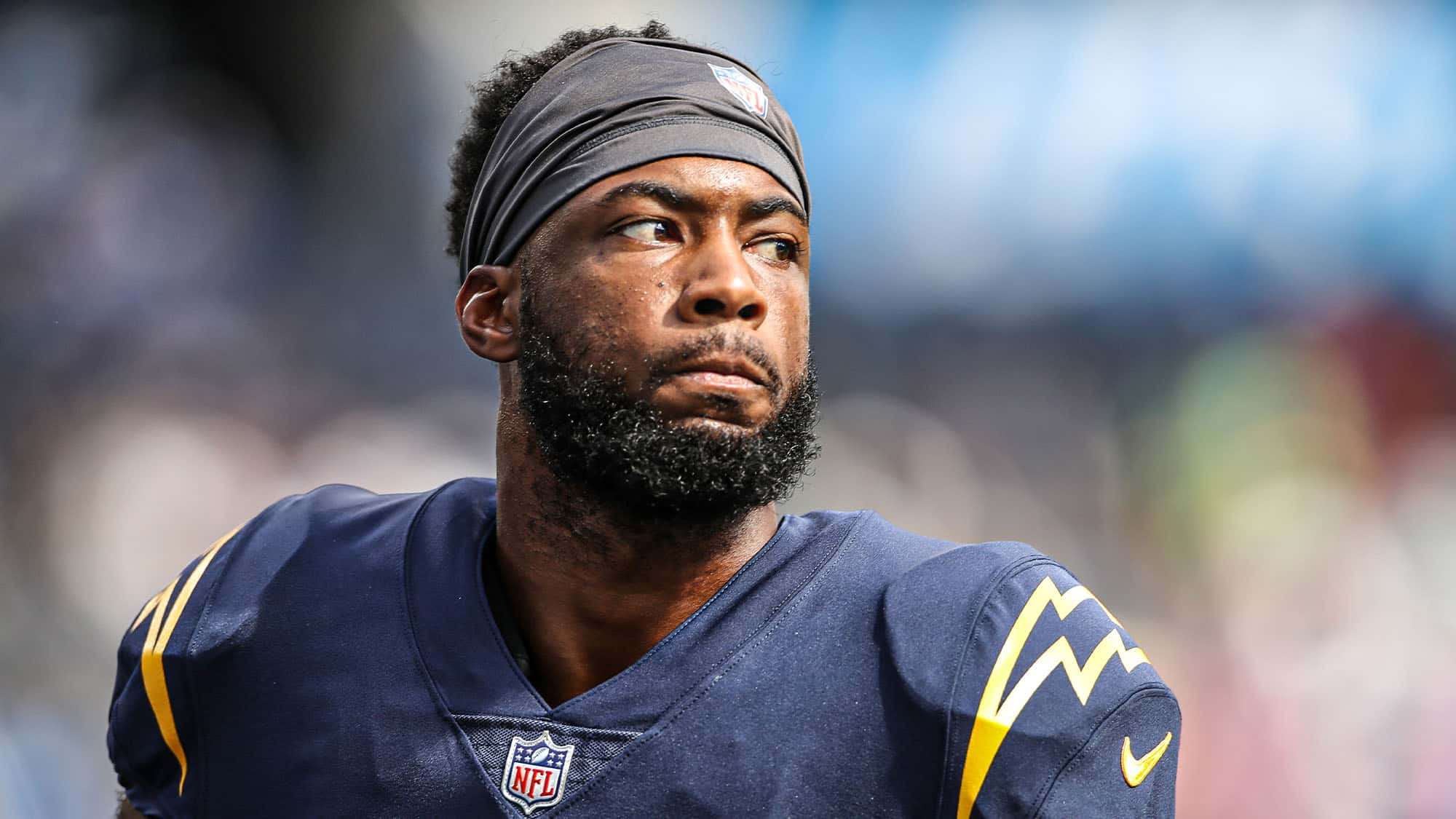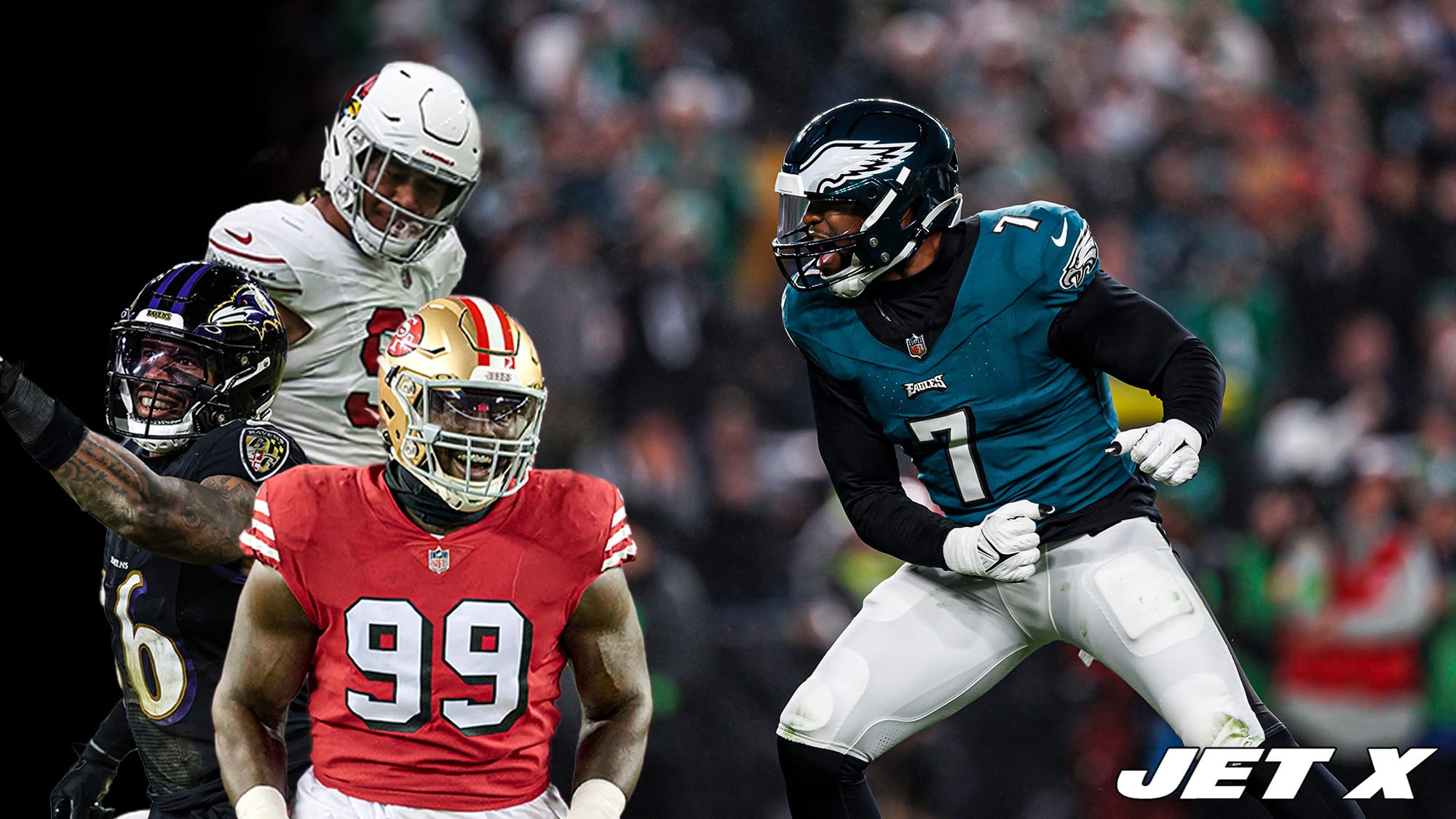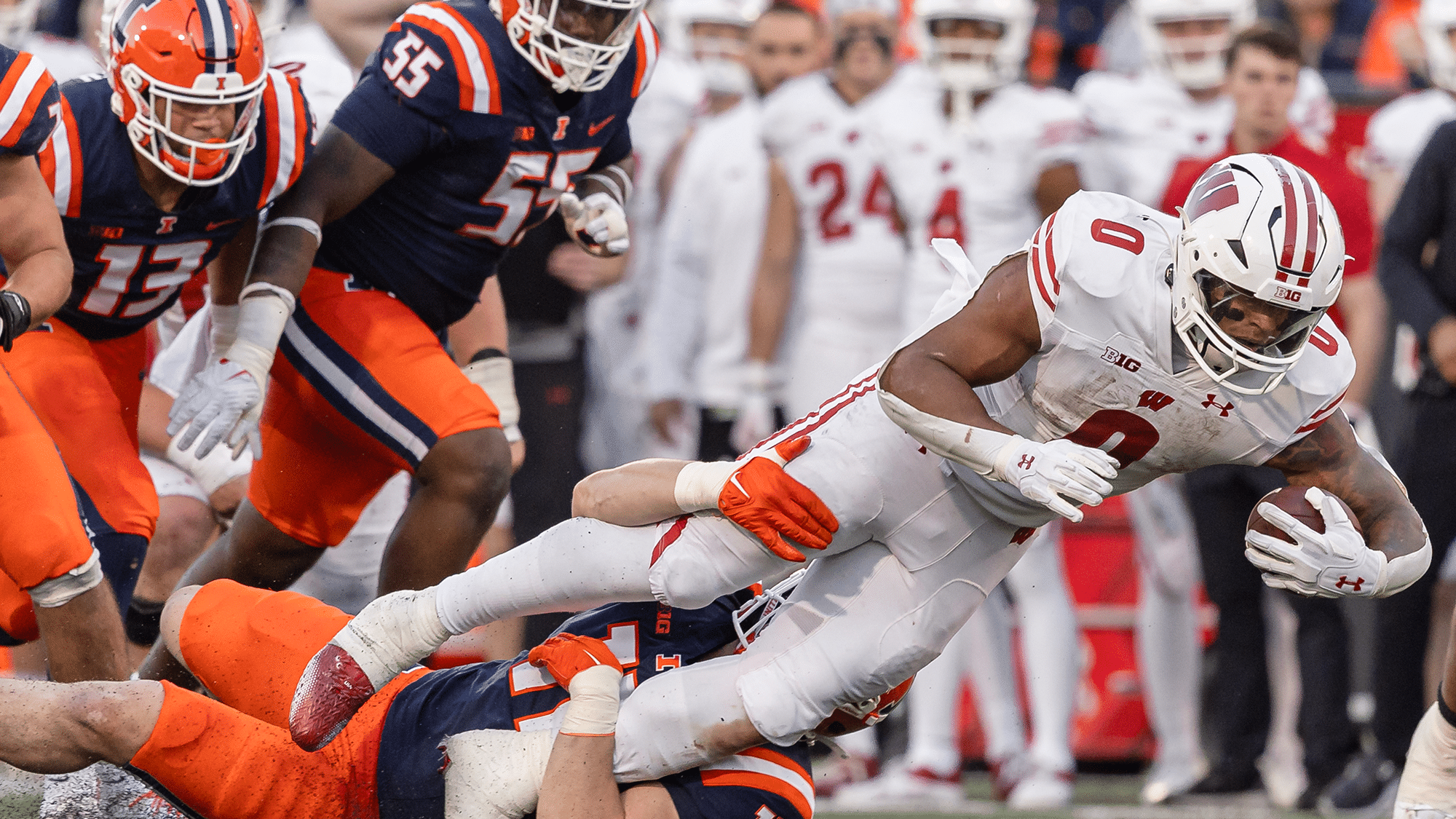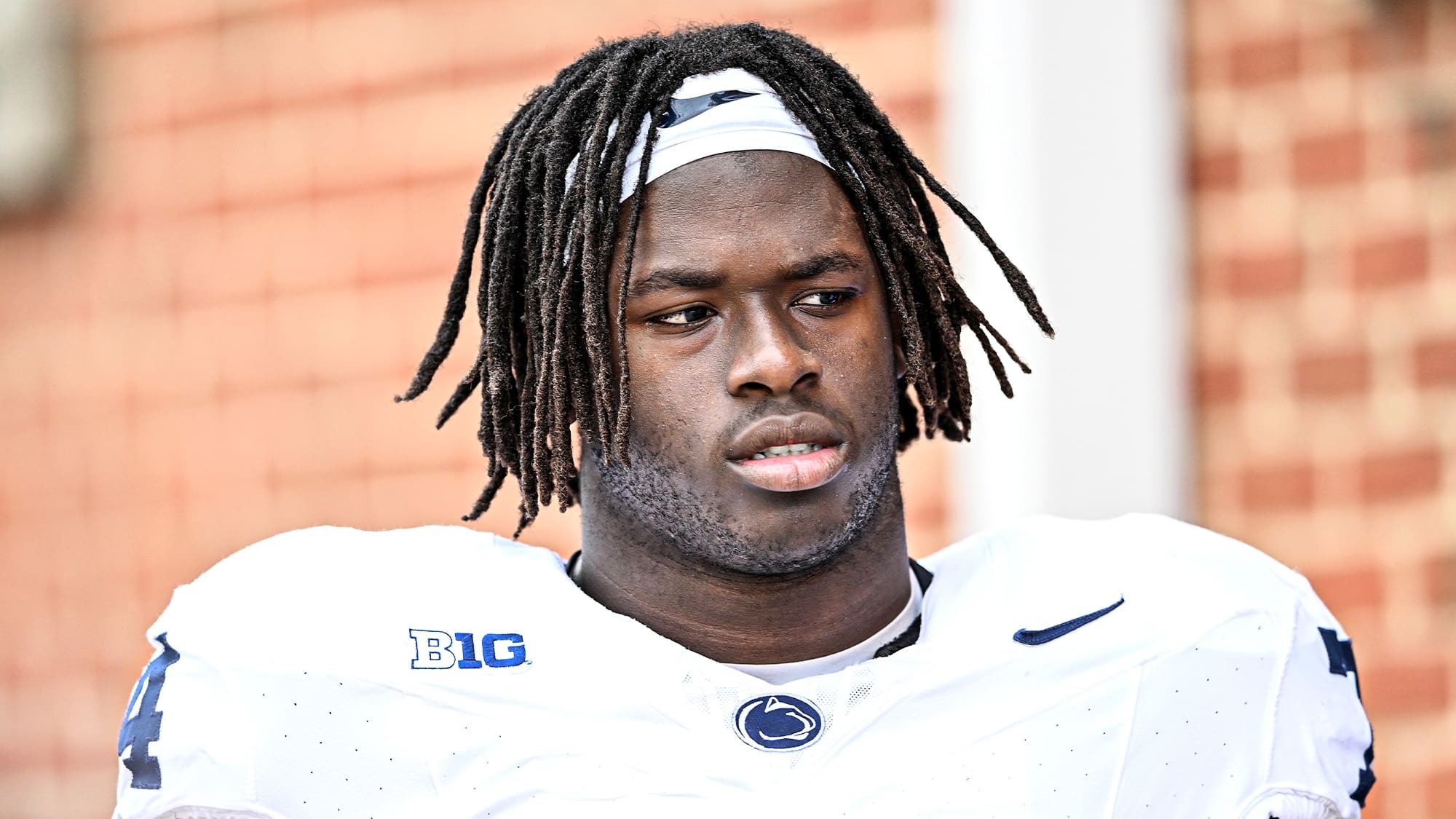What does Mike Williams bring to the New York Jets?
Mike Williams is officially a New York Jet. At long last, Garrett Wilson will be complemented by a legitimate No. 2 threat on the outside.
What should Jets fans expect to see from Williams on the field? What are his strengths and weaknesses? Is he a fit in the offense and alongside Wilson?
We’re going to answer all of those questions today with a thorough breakdown of Williams’ player profile.
To start, we’ll break down Williams’ role and usage in the Chargers’ offense. We’ll then analyze his strengths and weaknesses before rounding everything together to see how he fits in the Jets’ offense.
Role/Usage
Target volume
Outside of his rookie season, Williams spent his entire Chargers career as the No. 2 wide receiver behind Keenan Allen. In every season from 2018-2023, Williams ranked second among the Chargers’ WRs in targets per game.
Williams was targeted sporadically over his first few seasons but became a more prominent fixture in the passing game from 2021 onward. Through 2020, Williams only averaged 4.7 targets per game with a career-high of 6.0 in 2019. Since 2021, he’s averaged 7.8 targets per game, surpassing the 7.0 mark in each season. He was averaging a career-high 8.7 through three games in 2023 before his season-ending injury.
Mike Williams targets per game
- 2017: 2.3
- 2018: 4.1
- 2019: 6.0
- 2020: 5.7
- 2021: 8.1
- 2022: 7.2
- 2023: 8.7
Target depth
For his career, Williams’ average depth of target is 14.3 yards. This is very high. For perspective, it would have ranked ninth-highest among 70 qualified WRs in 2023. A high ADOT signifies that a player is primarily utilized as a downfield threat.
However, this number has declined since Williams’ target volume increased. Earlier in his career, Williams’ role leaned extremely heavily toward the deep game, as his ADOT was way up at 16.2 over his first four seasons. This would have led all qualifiers in 2023. But since 2021, Williams’ ADOT has dipped to 12.3, which would have ranked 28th out of 70 in 2023.
This doesn’t mean that Los Angeles decreased Williams’ usage in the deep game. His deep usage barely changed. It simply means that Los Angeles started using him much more frequently in the short part of the field, whereas earlier in his career, he was barely used there. This allowed Williams to get involved in the offense more consistently.
Here is a comparison of Williams’ targets per game in each part of the field between 2018-20 versus 2021-23:
- Deep (20+ yards downfield): 1.4 → 1.6
- Intermediate (10-19 yards): 2.1 → 2.0
- Short (0-9 yards): 1.4 → 3.1
- Behind LOS: 0.1 → 0.8
As you can see, Williams’ downfield usage has remained stable. He averaged 3.5 targets per game over 10 yards downfield from 2018-20, and from 2021-23, that number was 3.6.
A massive spike in short-field usage is what led to the jump in Williams’ overall target volume. From 2018-20, he only saw 1.5 targets per game under 10 yards downfield. That jumped all the way to 3.9 over the past three seasons.
Williams developed from an occasional big-play threat in the early part of his career to a well-rounded and heavily featured No. 2 target over the past three seasons.
Alignment
Williams leans toward lining up on the outside, but perhaps not as heavily as you’d think. For his career, Williams has lined up outside on 76% of his routes, compared to 24% in the slot.
From 2021-22, the Chargers had Williams leaning more heavily to the outside than usual. He set a career-high with 82.9% of his routes on the outside in 2021 before surpassing it again at 85% in 2022. Through three games in 2023, he was back down to a 71%/29% split.
Route tree
For this section, we’re going to focus on Williams’ 2022 and 2023 seasons to get an idea of how he was being used in his most recent action before coming to New York. This gives us a 16-game sample, as Williams played 13 games in 2022 and three in 2023. He was excellent in this approximately one-season sample size, catching 82 passes for 1,144 yards and five touchdowns.
Per NFL Next Gen Stats, here is a look at the distribution of Williams’ route tree from 2022-23 based on the percentage of his routes run (all routes, not just targeted routes) that were classified as each route type.
While Williams has added the short game to his repertoire in recent years, going deep remains his bread-and-butter. Williams ran a go route on 31.1% of his passing plays over the past two seasons, significantly higher than the 22.8% league average for WRs in 2023. He was targeted on 29 go routes and caught 11 passes for 262 yards and three touchdowns. That might not seem too efficient at first glance, but his 37.9% catch rate on go routes was 4.3% better than the 2023 league average for WRs (33.6%), so he is certainly an above-average vertical threat.
Hitch routes and crossing routes are Williams’ go-to in the short range. While the go route is his most common route, the hitch route was actually Williams’ No. 1 route in terms of targets (30), receptions (25), and yards (302). The respect commanded by his verticality helped open up this part of his game. Williams averaged 8.4 air yards per reception on these hitch routes. He often made these catches by selling vertical against soft cushions and stopping on a dime before the 10-yard mark.
Williams also did a lot of damage on crossing routes, particularly shallow crossers. This route type was the basis of his increase in short targets over the past few years. He caught 16-of-21 targets on crossing routes for 199 yards and two touchdowns, and on these plays, he averaged only 2.8 air yards per reception compared to 9.6 YAC per reception. Williams gained 77% of his crossing route yardage after the catch.
While his corner route frequency was high relative to the league average, he didn’t get targeted on them very often, seeing only six targets – although he caught three for a whopping 129 yards.
The Chargers rarely targeted Williams on screens before 2021, giving him just four screen passes over his first four seasons. Since then, his screen usage has increased to nearly a league-average frequency for WRs. Since 2021, Williams has been targeted on 24 screen plays, catching 23 of them for 130 yards. Considering the modest success on these plays (just 5.4 yards per target and a 21% first down rate), perhaps the Jets should consider decreasing his usage in this area.
Strengths
Contested catches
Williams boasts a massive frame – 6-foot-4, 218 pounds, 33⅜” arms – and he makes the absolute most of it. Some big receivers play small. Not this guy. Williams has the skill set to maximize his physical advantages.
For his career, Williams has a contested catch rate of 54.3%, per Pro Football Focus. To give you some perspective on how good that is, it is nearly 10% higher than the league average for WRs across the past three seasons (44.8%).
Williams was above that 44.8% mark in all seven of his career seasons – his career-low contested catch rate was 48.3% in 2020. He caught more than half of his contested targets in six of his seven seasons.
Despite playing in only 32 games, Williams is tied for ninth among WRs with 41 contested catches since 2021. His average of 1.3 contested catches per game leads all players in the NFL over this span. The distance between him and the second-ranked player is larger than the distance between the second-ranked player and the 10th-ranked player:
- 1. Mike Williams: 1.28 (41 in 32 G)
- 2. Terry McLaurin: 1.08 (55 in 51 G)
- T3. Mike Evans: 1.00 (48 in 48 G)
- T3. Justin Jefferson: 1.00 (44 in 44 G)
- 5. Michael Pittman: 0.98 (48 in 49 G)
- 6. Tee Higgins: 0.95 (40 in 42 G)
- 7. DeVante Parker: 0.94 (34 in 36 G)
- 8. Drake London: 0.94 (31 in 33 G)
- 9. Amari Cooper: 0.94 (44 in 47 G)
- 10. Jakobi Meyers: 0.91 (43 in 47 G)
On top of that, his 55.4% contested catch rate is ninth-best among the 59 WRs with at least 50 contested targets. Williams maintains a high level of efficiency on contested targets even while commanding them at an incredibly high rate.
Drops
Williams had drop issues early in his career but has developed excellent consistency as a pass catcher in recent years.
Over his first three seasons, Williams had a drop rate of 8.8%. For comparison, the 2023 league average was 6.5%. However, over the past four seasons, Williams’ drop rate is just 5.1%.
Williams had no drops in 2023 while making 19 receptions. In 2022, Williams had one drop while making 63 receptions.
Tremendous hands in all situations
So, not only does Williams excel at making the difficult catches, but he can be counted on to rarely botch the freebies, too. His hands are excellent in any situation.
Outside of a poor rookie year, Williams has generated a positive CROE (Catch Rate Over Expected) in six consecutive seasons, per NFL Next Gen Stats. This means he consistently catches more passes than expected when considering the estimated difficulty of his targets. The expectancies are calculated based on depth, coverage tightness, distance from the sideline, how fast he’s moving when the ball arrives, and various other factors that are measured using GPS tracking.
From 2018-2023, Williams’ CROE was an incredible 7.5%. He compiled a total of 36.6 receptions over expected, ranking as the eighth-most among WRs over this span:
- 1. Michael Thomas: 62.9
- 2. Tyler Lockett: 54.2
- 3. Stefon Diggs: 51.5
- 4. Adam Thielen: 44.9
- 5. DeAndre Hopkins: 43.5
- 6. Amari Cooper: 42.6
- 7. Justin Jefferson: 40.1
- 8. Mike Williams: 36.6
- 9. Julio Jones: 34.6
- 10. Allen Robinson: 30.9
Backing up his contested catch and drop numbers, Williams consistently posts a positive CROE in both low-percentage and high-percentage situations. Here is a look at his CROE numbers since 2018 in each of the four difficulty brackets:
- Targets with a completion probability of 75% or higher: 3.1% CROE (87.7% catch rate vs. 84.6% expected catch rate)
- Targets with a completion probability of 50-74.99%: 10.2% CROE (73.7% vs. 63.5%)
- Targets with a completion probability of 25%-49.99%: 8.9% CROE (45.2% vs. 36.3%)
- Targets with a completion probability of less than 25%: 7.3% CROE (22.6% vs. 15.3%)
Whether you need him to catch an extremely easy pass, a fairly easy pass, a 50-50 pass, or a prayer, Williams will come down with the ball significantly more often than the average receiver.
YAC relative to expectations
While the YAC department is not a huge part of Williams’ game, he does a good job for his size and role. Williams is tough to bring down after the catch and usually churns out more yards than he should.
Since 2018, Williams is averaging 1.1 YACOE per reception (Yards After Catch Over Expected), according to NFL Next Gen Stats. For reference, this would have ranked 16th out of the 53 WRs with at least 80 targets in 2023. Similar to CROE, YACOE uses GPS tracking data to estimate how many yards the player should be expected to gain based on the positioning, angles, and trajectory of all blockers and defenders on the field.
It’s the consistency of Williams’ YAC performance that stands out the most. He’s gained positive YACOE on 62.1% of his receptions since 2018. This would’ve ranked fourth-best among WRs with at least 80 targets in 2023, trailing only Deebo Samuel (73.7%), DK Metcalf (70%), and Brandon Aiyuk (62.3%). In 2022, Williams ranked sixth at 60%.
Let’s be clear: Nobody is going to mistake Williams for Deebo Samuel. Williams is not someone you want to throw a bunch of screens to – as we mentioned earlier, his screens since 2021 have yielded only 5.4 yards per play while netting a first down just 21% of the time. And as we saw with his route breakdown, nearly half of his route diet is built upon go routes and hitch routes, two routes that are not designed for facilitating YAC.
So, even though Williams isn’t a guy who the Jets will attempt to feature in the YAC game very often, Williams is a great YAC player within his role. He consistently uses his size and sheer effort to out-muscle defenders for extra yardage after the catch.
Weaknesses
Separation
Aside from injuries, the main weakness holding Williams back from becoming a superstar is his inability to create separation. He relies heavily on his contested catch ability to be effective. While he is dominant enough in that area to still be a great player overall, his lack of separation prevents him from demanding a higher target volume and becoming a more consistent threat on a play-to-play and game-to-game basis.
This chart (via X/@throwthedamball) shows that, while Williams is among the best of the best when it comes to his performance at the catchpoint and after it, his ability to create separation is on the lower end among WRs.

There are further metrics backing this up. According to ESPN Analytics’ receiver rankings, Williams had the third-best Catch Score among 131 qualified wide receivers in 2022. However, he ranked 85th in Open Score. Williams also fared well in YAC Score, ranking 25th.
Altogether, Williams’ strengths were enough to land him at 16th overall in ESPN Analytics’ 2022 rankings – tying him with Garrett Wilson – but the lack of separation prevents him from taking the next step and joining the superstar ranks.
Game-to-game consistency
Williams tends to be a boom-or-bust player from game to game.
There aren’t many receivers who hit the century mark as often as Williams. Since 2021, Williams has recorded nine games with 100+ receiving yards, ranking 15th among WRs despite missing 19 games. His rate of finishing with 100+ yards in 28% of his games (9 of 32) was 10th-best among WRs who played at least 20 games over this span:
- 1. Cooper Kupp: 52.6% (20 of 38)
- 2. Justin Jefferson: 50.0% (22 of 44)
- 3. Davante Adams: 38.0% (19 of 50)
- 4. Tyreek Hill: 36.0% (18 of 50)
- 5. CeeDee Lamb: 32.0% (16 of 50)
- 6. A.J. Brown: 31.9% (15 of 47)
- 7. Ja’Marr Chase: 31.1% (14 of 45)
- 8. Amon-Ra St. Brown: 30.6% (15 of 49)
- 9. Keenan Allen: 28.2% (11 of 39)
- 10. Mike Williams: 28.1% (9 of 32)
- 11. Stefon Diggs: 28.0% (14 of 50)
- 12. Chris Olave: 25.8% (8 of 31)
- 13. Amari Cooper: 25.5% (12 of 47)
- 14. Tee Higgins: 23.8% (10 of 42)
- 15. D.J. Moore: 21.6% (11 of 51)
However, Williams is equally prone to duds. Over the same span, Williams posted under 40 receiving yards in 10 of his 32 games (31%).
This means that, in 19 of his last 32 games dating back to 2021, Williams had either 100+ receiving yards or under 40 receiving yards, making up 59% of his games. About three out of every five games were considered either a classic or a stinker. You don’t get much in the middle with Williams.
The Jets will be thrilled to have Williams’ upside. Consider this: Williams has gone for 100+ receiving yards in six of his past 17 games. In comparison, Jets WRs not named Garrett Wilson have gone for 100+ yards in six of the team’s past 70 games. That’s a span stretching from Week 15 of the 2019 season through the 2023 season finale. The last to do it was Elijah Moore in 2021, meaning Wilson has never had a teammate pull it off since he’s been in the league.
Still, Williams’ inconsistency is something to keep an eye on. This is something that can be traced back to his lack of separation. As a player who doesn’t consistently create wide-open, high-percentage catches for himself, his production is erratic since he relies on plays that are toss-ups even if you’re as great at them as he is. If he goes 0-for-2 on jump balls thrown 40 yards downfield, he might end up having a quiet day. But if he grabs both – something he is totally capable of – 100 yards is easily within reach.
Injuries
Staying healthy is the main concern for Williams. I think his injury concerns are slightly overblown by some, but they are still legitimate. They are the main reason New York was able to nab him on a surprisingly affordable one-year deal.
Williams is coming off a torn ACL that he suffered in Week 3, during the third quarter of a September 24 game against the Vikings. It halted a dominant performance in which he had already racked up seven receptions for 124 yards and a touchdown.
On Wednesday, Williams told the New York media that he is 4.5 months removed from ACL surgery and his recovery is on schedule. He fully expects to play in Week 1.
Prior to the ACL injury, Williams’ availability was fairly normal over the past few seasons, although he had some occasional nagging injuries. Over the previous five seasons (2018-22), Williams was averaging a very reasonable total of 15.0 games per year, missing seven regular season games over this span. That’s nothing unusual for an NFL starter.
The 2022 season was Williams’ roughest year in the injury department since his 2017 rookie season. He missed four regular season games and one playoff game. Before this, he had gone four consecutive seasons without missing multiple games.
In 2022, Williams missed four games in the middle of the year with an ankle injury, although the injury essentially caused him to miss five games. He was out for two games from Weeks 9-10 and returned in Week 11, but he aggravated the injury and left the game after just six snaps, causing him to miss the following two games. Williams returned to play five more games, but he suffered a back injury in the regular season finale, which was projected to sideline him for 2-3 weeks. It caused him to miss the Chargers’ wild card loss in Jacksonville.
Williams missed one game in 2021 due to COVID-19, although he did not miss any games that year due to actual injuries. In 2020, he missed one game, which was due to a hamstring injury. However, he left after two snaps in a Week 14 game due to a back injury, although he returned for the rest of the season.
Back injuries have been frequent for Williams. In addition to the two back injuries we already mentioned, he missed one game with a back ailment in Week 4 of 2019, although he returned the next week and never missed another game.
Williams’ history of back injuries can be traced all the way back to college. In 2015, when he was a true junior at Clemson, Williams fractured his neck after colliding with the goalpost in Clemson’s first offensive series of the season. This knocked him out for the season and he received a medical redshirt. Williams returned for a dominant 2016 season in which he did not miss any games, but the neck/back injury crept back up in his first NFL offseason.
In 2017, Williams missed all of OTAs and training camp due to a herniated disc in his lower back. This injury lingered into the year and caused him to miss the team’s first five games. Williams returned in Week 6 and played all but one of the remaining games, missing a Week 13 contest due to a knee injury.
The 2018 season was Williams’ lone season with perfect attendance.
Williams’ injury history is undoubtedly a major concern. He must show he can bounce back after a torn ACL at 30 years old, and he also has a long history of neck and back injuries.
With that said, Williams did manage to suit up for an average of 15 games per year over a half-decade span before his ACL injury, so we’re not talking about Tyron Smith or David Bakhtiari here. As long as Williams recovers smoothly from his ACL injury (definitely not easy or guaranteed), he should have a good chance of playing in nearly all of the team’s games.
Fit
There are quite a few reasons why Williams is an ideal fit as the Jets’ WR2 beside Garrett Wilson.
First of all, Williams has already spent his whole career proving that he can thrive in this role. Williams was the Chargers’ WR2 behind Keenan Allen for the past six years. He’s shown that he can provide great production as the secondary threat in an offense that has a clear-cut WR1.
Not only that, but Allen is a similar player to Wilson. They are both high-volume target magnets who demand a ton of opportunities through their incredible route running, especially underneath. Like Allen, Wilson is incredibly difficult to cover in the short-to-intermediate area, which allows his team to pepper him with targets. This leads to him drawing plenty of double-coverage looks and press-man coverage.
Williams proved he can maximize the attention demanded by Allen. With Allen pulling the defense toward the line of scrimmage, Williams was presented with room to work over the top, and he made defenses pay when they gave him opportunities to work vertically against one-on-one coverage. Next to Wilson, he should be able to do the same thing.
It works the other way, too. With a threat like Williams on the other side, teams couldn’t afford to double Allen, or else Williams would scorch the one-on-one coverage over the top. Thanks to Williams, Allen had the opportunity to face favorable matchups.
Wilson has never enjoyed this benefit. Since the Jets have not had any legitimate No. 2 threats at the WR position in Wilson’s career, teams have been able to comfortably double-team Wilson with no repercussions. With Williams in the fray, that won’t happen anymore. His presence will make Wilson’s life easier than it’s ever been in the NFL.
Another reason Williams will fit in perfectly is that he covers for some of Wilson’s limitations.
Contested catches are an area where Wilson has struggled. He’s caught just 32.9% of contested targets in his career. To be fair, that number will likely improve with better quarterbacking. Aaron Rodgers can set up a jump ball better than Zach Wilson. Plus, since Garrett has been the team’s only threat, it caused the Jets to chuck up a ton of essentially uncatchable prayers in his direction, which surely tanked his contested catch rate.
Nonetheless, 32.9% is extremely low. Wilson surely has work to do in the contested catch area and the film backs it up.
While we wait to see if Wilson can develop into a legitimate contested-catch threat, it’s great for the Jets to have a player in Williams who has proven that he is one of the league’s best players in that area. Rodgers will not have to rely solely on Wilson in just-chuck-it-up situations.
Speaking of Rodgers, I think Williams’ skill set is going to work extremely well with the veteran quarterback.
Let’s refer back to Williams’ route breakdown from earlier:
Now let’s take a look at the route-type distribution of Rodgers’ pass attempts from 2019-21 when he played under Nathaniel Hackett:
The first thing that stands out is the reliance on go routes. As we discussed earlier, Williams runs a ton of them. This makes Rodgers a tremendous match for him, as the go route was Rodgers’ second-favorite route relative to the league average during his Hackett days.
In fact, Rodgers had the second-most attempts (186) and second-most passing yards (2,168) on go routes over his final three seasons in Green Bay. Rodgers loves to throw deep balls up the sideline and give his guys chances to make plays. Williams is going to feast on go routes with Rodgers.
Another route that both players prefer is the crossing route. This route type was the main reason behind Williams’ spike in target volume over the past few years. The Chargers pumped up Williams’ short targets from 2021-23, and a large chunk of those newly added short targets were shallow crossers, which Williams feasted on (16 catches on 21 targets for 199 yards and 2 TD). Meanwhile, Rodgers likes targeting crossers, as it was his fourth-favorite route relative to the league average under Hackett.
One area where the two players do not match is the hitch route. It was Williams’ top route in terms of receptions, targets, and yards over the past two seasons, whereas Rodgers has a heavy disdain for it compared to the league average. Nonetheless, it’s not as if Rodgers never targeted them. Williams can be his go-to guy in the event that he does look for the hitch route. And if working with Rodgers means Williams will transfer some of his hitch routes into go routes, that’s not a bad thing. It would only make him more explosive.
Overall, Williams projects as a dream fit in an Aaron Rodgers-led offense as the WR2 complement to Garrett Wilson.
The Jets got the best possible WR2 option
Every day throughout the past two-and-a-half months, getting a No. 2 receiver was a constant talking point in the world of New York Jets football. Fans clamored for just about every potentially available big-name receiver whose name made it into the news.
While it was frustrating to watch the Jets miss out on one potential solution after another, I think the Jets ended up getting the best possible solution. Of all the names who were discussed – Mike Evans, Calvin Ridley, Courtland Sutton, Diontae Johnson, Jerry Jeudy, Tee Higgins, etc. – I would argue Williams is a better fit and a better player than all of them except for Evans.
And that’s without adding cost into the mix. The Jets were able to get Williams for a substantially cheaper contract than Evans or Ridley. They also acquired him without trading any draft picks, which would have been necessary to get any of the other aforementioned players.
Throw cost into the mix, and Williams was the clear-cut best-case scenario to fill the Jets’ WR2 role.
The obvious elephant in the room is Williams’ injury history. It’s the reason he was available in the first place and the reason he came so affordably. The risk associated with him is undeniable.
But it’s a risk worth taking. For an all-in Jets team, the goal is to push the ceiling as high as possible. That was the reason why signing Tyron Smith made sense, and the same applies to Williams. By following up Smith with Williams, the Jets have doubled down on their all-in mentality. It’s a refreshing change after the franchise acted with a negligent degree of complacency throughout 2023 following the acquisition of Aaron Rodgers.
It no longer feels like Rodgers’ presence is the only thing fans can cling to for optimism. Now, it feels like the Jets have a stacked football team on both sides of the football. Rodgers doesn’t have to be the savior.
The injury concerns are frightening, yes. But if Williams and Smith didn’t have injury concerns, they wouldn’t be on the Jets right now.
The question marks around Williams and Smith presented the Jets with a golden opportunity to go all-in on this short-term Super Bowl window with Rodgers, and they rightfully seized it. If the Jets stay healthy – and that’s a big if – they have perhaps the most talented roster in franchise history.














